America’s Forgotten High-Value Currency
In the United States today, $100 is the largest denomination you’ll ever see in circulation. But that wasn’t always the case. I remember when I was a kid — we’d sometimes boast (falsely, of course) about having some giant bill, like a $1,000 note. In truth, the image in our heads (mine, at least) was basically just Monopoly money. I had no idea that bills above $100 were ever a real thing. But they were. For much of the 20th century, the U.S. printed bills in denominations of $500, $1,000, $5,000, and even $10,000 — legally backed by the U.S. Treasury and, for a time, redeemable in gold. There was even a $100,000 bill, though it was never meant for general use.
Why did these bills exist? Who used them? And why did they disappear?
Let’s take a look.
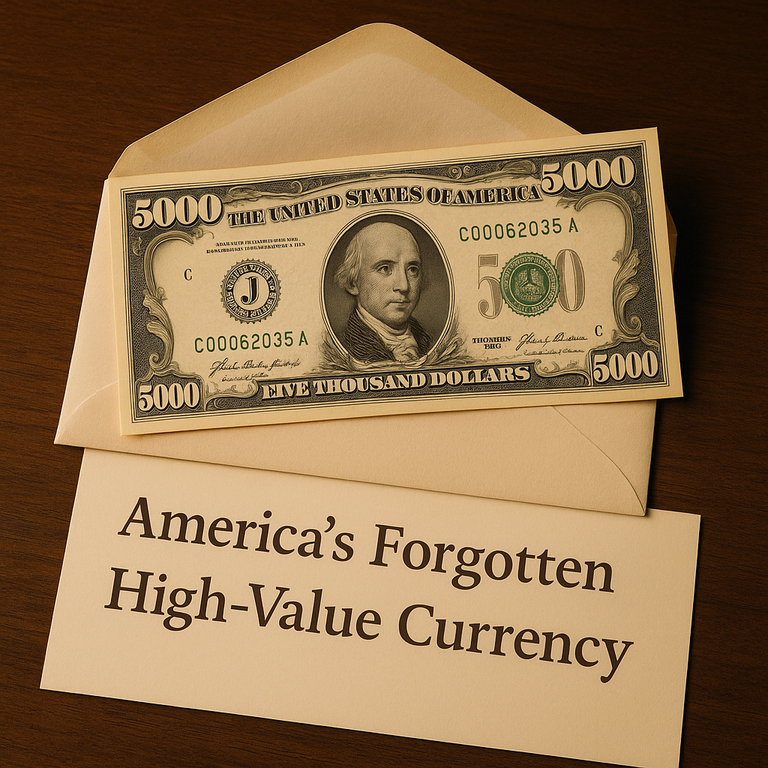
A Brief History of Big Bills
High-denomination U.S. bills were first issued in the 19th century, but most of the notes we remember today were standardized in the Series of 1934, authorized during the Great Depression. These large-value notes were never meant for daily use by the general public. Instead, they served a specific function: settling large transactions between banks and Federal Reserve branches in the days before digital transfers and wire payments.
This doesn’t mean they didn’t show up in the hands of ordinary people from time to time. They did. And people were definitely aware of them — so they occasionally turned up in popular media. One of these high-value notes famously plays a role in a Philip Marlowe novel.
From the Long Goodbye:
He thanked me and hung up. I wondered who could have given me the plug. I thought it might be Sewell Endicott and called him to find out. But he had been out of town all week, and still was. It didn’t matter much. Even in my business you occasionally get a satisfied customer. And I needed a job because I needed the money — or thought I did, until I got home that night and found the letter with a portrait of Madison in it.
That portrait of Madison included with the letter was a $5,000 note. Quite a lot of money even now, but considerably more when Chandler wrote the book in 1953.
Here are the main high-denomination notes (and their adjusted values in today’s money). Note: For inflation-adjusted values, I’m going to use the year 1969, when the large notes were withdrawn from circulation. Go back further, and of course, they were worth even more. We’re also going to use the oldest form of the bills. Some (like the $500) had many many versions. Maybe I’ll feature more details in a later post, but just one for now.
$500 Bill

(via Wikipedia)
- Featured William McKinley.
- First issued in 1862 and then reissued in 1928 and 1934.
- Inflation-adjusted value: $4,370.50
$1,000 Bill
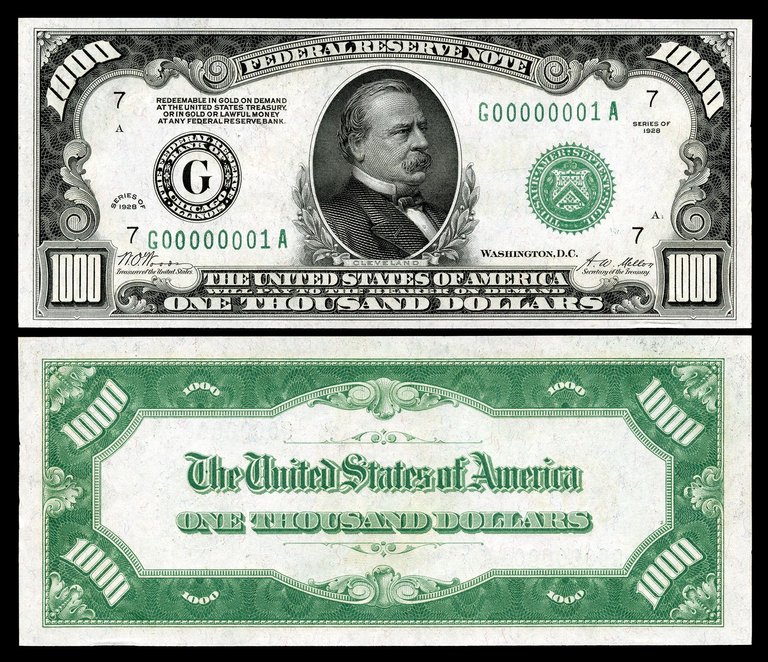
(via Wikipedia)
- Featured Grover Cleveland.
- Used widely in interbank transfers.
- Inflation-adjusted value: $8,741.01
$5,000 Bill
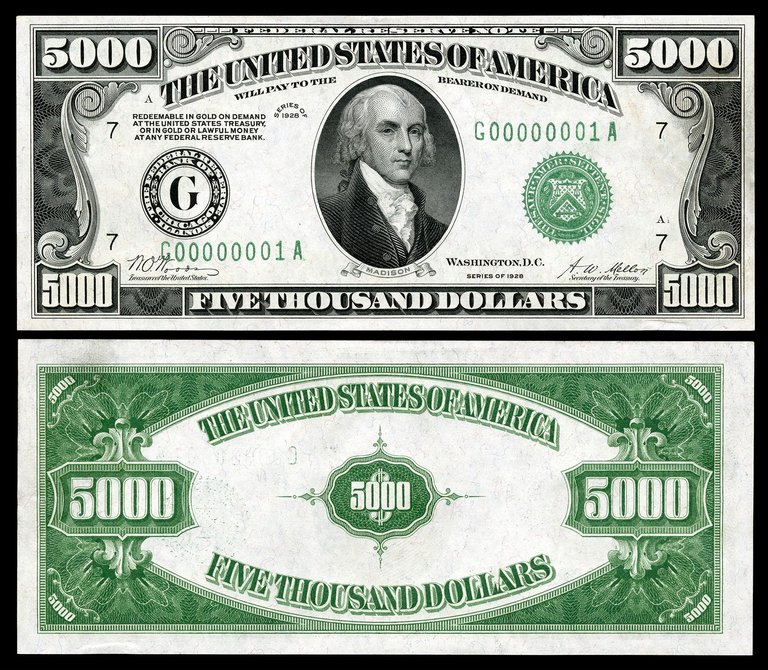
(via Wikipedia)
- Featured James Madison.
- Rarely seen even in banks.
- Inflation-adjusted value: $43,705.04
$10,000 Bill
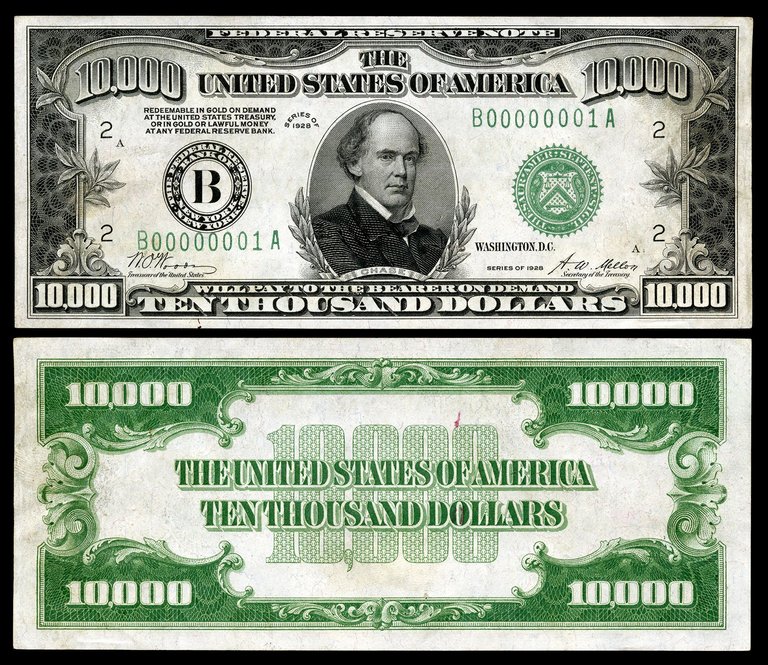
(via Wikipedia)
- Featured Salmon P. Chase, who served as both Treasury Secretary and Chief Justice.
- Inflation-adjusted value: $87,410.08
$100,000 Gold Certificate
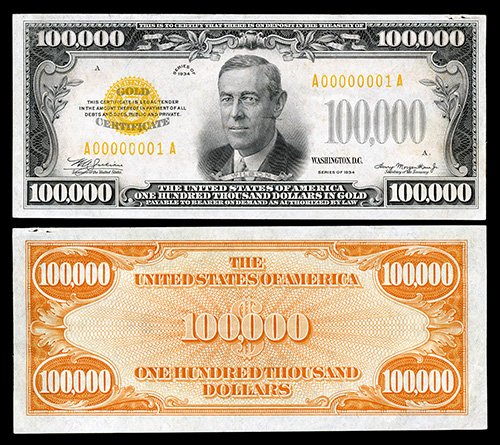
(via Wikipedia)
- Featured Woodrow Wilson.
- Never issued to the public — used only for internal Treasury and Federal Reserve transactions.
- Inflation-adjusted value: $874,100.82
These were serious instruments for serious transactions — essentially analog tools for a pre-digital financial world.
Incidentally, just for kicks, let’s go back to that $5,000 note mentioned in The Long Goodbye. I said it had the 2025 equivalent of $43,705.04 when the bills were withdrawn in 1969. But what about in 1953, when Chandler’s novel was published?
Adjusted from 1953 to 2025, it would be worth approximately $60,073.97.
Yeah… a lot of money. Consider that when you read the book to better understand Marlowe’s reaction.
Why Were They Needed?
Before electronic payments, clearinghouses and reserve banks had to physically move money to settle accounts. If a bank needed to transfer $1 million to another, doing so with $10 or $20 bills would be both absurd and risky. Even $100s would be pushing it. Enter the $10,000 bill: lightweight, efficient, and backed by the full faith and credit of the United States.
Carrying these notes was rare, even for wealthy individuals. But in the world of high finance, the notes were indispensable. They offered security and speed at a time when armored trucks and air transport were still developing technologies.
Why Were They Discontinued?
In 1969, the Treasury officially halted the printing and circulation of all bills above $100. By then, electronic funds transfer (EFT) systems had started to replace the need for physical large-sum currency. The rise of computers, wire transfers, and improved banking networks made big bills not only unnecessary, but a potential liability.
There was also the issue of crime.
High-denomination bills were a favorite tool of organized crime syndicates, drug traffickers, and money launderers. It’s far easier to move $1 million in $1,000 bills than in $20s. With growing concern about illicit finance during the 1960s — particularly under President Nixon’s crime crackdown — these bills quietly faded from use.
Today, they’re all officially discontinued. While still legal tender, they are almost never seen outside of museums or private collections. In fact, collectors often pay well above face value for them, especially for the rarest and best-preserved notes. A $10,000 bill in pristine condition can fetch several hundred thousand dollars at auction.
Will High-Value Notes Ever Return?
Maybe! But…. almost certainly not. In today’s world of instant transfers and digital wallets, there’s little practical need for paper currency above $100. If anything, the trend is moving in the opposite direction: toward cashless payments and more granular digital tracking.
That’s not necessarily a good thing. If you are a user of cash, you may lament that we don’t really have any high-value notes and you have to instead use a stack of $100s. Consider that the $100 had roughly $874.10 in buying power when these larger notes were discontinued in 1969 and that we have nothing today with that level of buying power. So you see, if we wanted something with the same buying power as the $100 used to have we’d need a $1,000 note right now. But it just ain’t going to happen.
Of course the conspiracy nuts would say that taking away our cash options is purposeful. I wouldn’t go that far. I think just the convenience of digital makes those in power not want to deal with the inconvenience of cash. But whatever the case may be, it’s unlikely we’ll ever see anything so large again.
At any rate. High-value notes. They were real and are always very interesting to see — and collectors pay a mint for them, so if you ever come across one, you’re extra lucky.
You received an upvote of 100% from Precious the Silver Mermaid!
Thank you for contributing more great content to the #SilverGoldStackers tag.
You have created a Precious Gem!
I hadn't realized that either, about 100s being the highest now, till late last fall when I was concerned about what might happen to our financial system because of the politics. I chose to take some cash out of the bank for a while and that is when I learned there were no larger denominations. I found it interesting, especially since I had not heard or paid attention and had no idea the higher bills were gone.
Yep, unfortunately they are a thing of the past. Before moving to Japan, whenever I went to a bank to cash my paycheck in the States I'd always ask if they had any larger bills. I didn't really expect to find any, just more of a "might as well try" thing. No big bills, but I did get some Ike dollars a few times.
It's interesting that the US (as a "major" currency) diesn't have anything higher than a $100 bill in circulation.
I know Switzerland still has 1,000 Franc notes ($1,200 and change) and until recently there were 500 Euro notes in circulation. That said, I also realize many countries are scrapping high denomonation notes as a way to control "illicit activity."
I didn't realized Switzerland still has the 1,000 Franc note. I think unfortunately all high value notes will eventually be phased out in many countries as digital payments become easier and easier.
Cash is king, whether the grid is down (as happens due to hurricanes, etc) or you just want another layer of privacy. Government wants us surveiled and dependant, so despite inflation, I doubt these bigger bills will return. And the official inflation numbers undersell the situation.
Our new product line of $100 Gold Coins will have the Spending Power of 10,000 of today's Fiat USD's...
Awesome post. It was a good follow up to the one you posted the other day and the discussion we had. I still wish they would at least come out with a 500 bill again. It sure would make paying cash for used cars and stuff easier to manage.
Thanks!
You and me both. Having larger bills would be very convenient in some situations.
No doubt, today we learned a bit of history about these bills of great value, it makes sense that banks have issued them for transactions of large sums of money because with bills of 10 or 20 not even today would have ended haha 😂 virtual transactions have facilitated many operations, are risky, like everything, but streamline the procedures and no longer need these bills, only as something historical worth seeing as a relic hehe
https://www.reddit.com/r/usa/comments/1l37i9w/americas_forgotten_highvalue_currency_peakd/
This post has been shared on Reddit by @blkchn through the HivePosh initiative.
Extremely fascinating. I still like my $2 bills haha.
I always try to get some $2 bills when I take trips to the States. Ike dollars or other dollar coins as well. Anything unusual that I can spend in the stores to surprise cashiers who don't know any better.
Awesome! I never spend my $2 bills, I just keep them with my coin collection. But yea there are still lots of Americans that haven't seen a $2 bill haha
I didn't know about this, how interesting, I had no idea that higher denomination bills previously existed in the US. I enjoyed reading your post.
Great post, @dbooster !
!BBH
!LADY
View or trade
LOHtokens.@silversaver888, you successfully shared 0.1000 LOH with @dbooster and you earned 0.1000 LOH as tips. (7/50 calls)
Use !LADY command to share LOH! More details available in this post.
Important